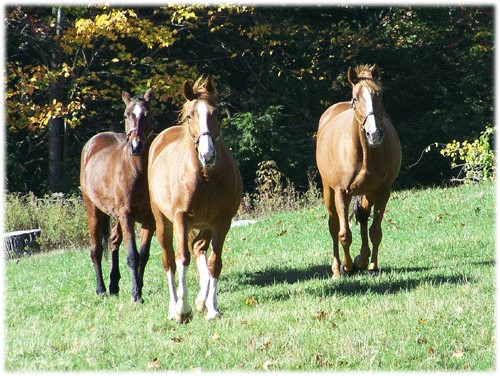
Agricultural News
Hot Temps Can Be Handled by Horses- Most of the Time
Wed, 04 Aug 2010 15:41:48 CDT
 Oklahoma temperatures are running wild at approximately 105 degrees Fahrenheit, which are leading a number of equine owners to study their horse's heat tolerance with more than a little caution.
Oklahoma temperatures are running wild at approximately 105 degrees Fahrenheit, which are leading a number of equine owners to study their horse's heat tolerance with more than a little caution.
"Other than a general lack of enthusiasm and desire to move to shade, a normal well-acclimated horse should be able to handle Oklahoma's heat and humidity with little concern," said Dave Freeman, Oklahoma State University Cooperative Extension equine specialist. "However, the need for owner awareness increases when a horse begins to exercise and engage in more strenuous physical activity."
A horse's body temperature if it is normally around 101 degrees Fahrenheit will increase a few degrees with exercise in hot summertime environments. If not exercising, a horse's heart rate should be around 40 beats per minute; respiration rate 12-20 breaths per minute, though this is variable; and body temperature around 101-102 degrees Fahrenheit.
Maximum heart rates during heavy exercise may reach 200 beats per minute or more, and respiration rates can triple or race even higher. Intense levels of work can raise a horse's rectal temperatures to 104 degrees Fahrenheit, plus or minus, which for any substantial length of time will be harmful.
"This means that it is vital that the horse has the ability to decrease excessive body temperature quickly during recovery," Freeman said. "Otherwise, heat stress becomes a big concern."
Under most conditions, equine owners should expect a horse's major physiological measurements heart rate, body temperature and respiration rate to decrease dramatically within 5 minutes following heavy or prolonged exercise.
"A horse should reach characteristic 'resting values' within 10-15 minutes at the longest," he said. "If the horse is really 'hot' from exercising, recovery is best done by hand, walking the animal in an area with good air flow and away from direct sunlight."
Freeman explains that cooling the horse's body with water is recommended as long as the equine's heart and respiration rates have dropped to near 'resting value' levels, and possibly even sooner under critical heat stress conditions.
"Humidity and air flow causes evaporation; as a result, your horse may sweat more than you think," Freeman said. "That makes it especially important to pay attention to the animal's physical clues its respiration rate, heart rate and body temperature during times when your horse may be at risk from the heat."
If a horse does not appear to be producing sufficient sweat, the owner should contact his or her local veterinarian, who can quantify the animal's sweat rate and take appropriate action.
"Veterinarians have evaluation methods in which drugs are administered that cause a horse to sweat, and might even use absorbent pads to quantify losses," Freeman said
.
Anhydrosis, or the inability to sweat, is a problem with a small percentage of horses, but one that should be diagnosed accurately so that an equine owner is able to determine the extent of use to which the horse can be put during periods of excessive summer temperatures.
WebReadyTM Powered by WireReady® NSI
Top Agricultural News
More Headlines...




















